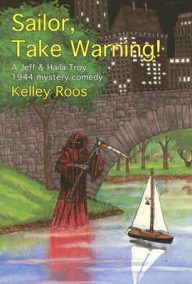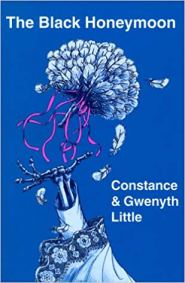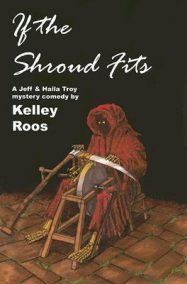Rue Morgue Press
#193: Sailor, Take Warning! (1944) by Kelley Roos
 Sometimes you just have to bite a bullet: following the exceptionally sad loss of the Rue Morgue Press, this is the final Jeff and Haila Troy novel currently available, but, well, let’s enjoy it, eh? Audrey and William Roos did such a great job with so many aspects of the writing in these first four books — the dialogue is genuinely funny, the plots mostly move at a great pace, the mysteries are intriguing, and third book The Frightened Stiff is a genuine genre classic for all time — that we shouldn’t get too weighed down with lamenting their unavailability. Common sense will prevail, they’re too good to let go out of print for any length of time, and this won’t be the last we see of the Troys. Right?
Sometimes you just have to bite a bullet: following the exceptionally sad loss of the Rue Morgue Press, this is the final Jeff and Haila Troy novel currently available, but, well, let’s enjoy it, eh? Audrey and William Roos did such a great job with so many aspects of the writing in these first four books — the dialogue is genuinely funny, the plots mostly move at a great pace, the mysteries are intriguing, and third book The Frightened Stiff is a genuine genre classic for all time — that we shouldn’t get too weighed down with lamenting their unavailability. Common sense will prevail, they’re too good to let go out of print for any length of time, and this won’t be the last we see of the Troys. Right?
Continue reading
#181: The Tuesday Night Bloggers – Strangers in Strange Lands: When East Comes West…

Alongside classic detective fiction and locked room/impossible crime mysteries of every date, stripe, and hue, I read a moderate amount of both classic and modern SF. And as much as I rejoice in the closedness of the ‘rules’ of detective fiction, I take equal delight in the free-form craziness that can open up in front of you in excellent SF.
Continue reading
#133: Everything is Rather Frightening in The Black Rustle (1943) by Constance and Gwenyth Little
Over at the excellent and superbly-titled Exploring the History of Women in Mystery blog, wrangler “Unpredictable Notes” recently put up this brief summary of the EIRF school as outlined in Jacques Barzun and Wendell Hertig Taylor’s A Catalogue of Crime (1971). EIRF is a step on from HIBK (Had I But Known) and stands for Everything is Rather Frightening:
In fact, since the modern psychological novel has devoted itself to exploring the abnormal and oddly alarming, no great originality was needed to raise the emotional pitch of the murder another notch and made HIBK into EIRF – Everything is Rather Frightening.



 There are times when it’s possible to pinpoint the exact moment when a novel doesn’t fulfil its promise, and given the intricacy of many novels of detection these can sometimes be very keenly felt. Perhaps the detective is an absolute duffer (an accusation frequently levelled at Freeman Wills Croft’s Inspector French), or the guilty party comes disappointingly out of nowhere (as in John Dickson Carr’s The Blind Barber), or perhaps the solution offered up to a brilliant problem is a shade on the simplistic side (the disappearance from the locked bathroom in John Sladek’s otherwise-superb Black Aura springs to mind). For this second novel by husband and wife team Kelley Roos, I’d say the main problem is in the selection of the victim: the setup is excellent, the characters are a delight, and come the murder…the most obvious victim is selected and the book never quite recovers.
There are times when it’s possible to pinpoint the exact moment when a novel doesn’t fulfil its promise, and given the intricacy of many novels of detection these can sometimes be very keenly felt. Perhaps the detective is an absolute duffer (an accusation frequently levelled at Freeman Wills Croft’s Inspector French), or the guilty party comes disappointingly out of nowhere (as in John Dickson Carr’s The Blind Barber), or perhaps the solution offered up to a brilliant problem is a shade on the simplistic side (the disappearance from the locked bathroom in John Sladek’s otherwise-superb Black Aura springs to mind). For this second novel by husband and wife team Kelley Roos, I’d say the main problem is in the selection of the victim: the setup is excellent, the characters are a delight, and come the murder…the most obvious victim is selected and the book never quite recovers.
 A little charm goes a long way – ask any bank teller or helpline operative, or indeed any fan of Golden Age crime fiction. Because, while a lot of absolutely wonderful books came out of this genre at that time, the fact is that a lot of what was published then and is popular now adhered to a particular school of writing and runs on very familiar rails. But the key thing is that so much of it is charming without having to innovate, and once you jettison any notions about every single book from the Golden Age being a complete game-changer you find a lot of joy there. Which astonishingly back-handed praise brings us to my first (but the chronological second) Hildegard Withers mystery by Stuart Palmer, possibly the first book I’ve really enjoyed for a long time in 2016 even though it does very little new or surprising.
A little charm goes a long way – ask any bank teller or helpline operative, or indeed any fan of Golden Age crime fiction. Because, while a lot of absolutely wonderful books came out of this genre at that time, the fact is that a lot of what was published then and is popular now adhered to a particular school of writing and runs on very familiar rails. But the key thing is that so much of it is charming without having to innovate, and once you jettison any notions about every single book from the Golden Age being a complete game-changer you find a lot of joy there. Which astonishingly back-handed praise brings us to my first (but the chronological second) Hildegard Withers mystery by Stuart Palmer, possibly the first book I’ve really enjoyed for a long time in 2016 even though it does very little new or surprising.
 So, from one Australian author last week – the entertainingly bonkers world of Max Afford’s Owl of Darkness – to two this week – the entertainingly bonkers world of the Little Sisters. This is my first foray into the
So, from one Australian author last week – the entertainingly bonkers world of Max Afford’s Owl of Darkness – to two this week – the entertainingly bonkers world of the Little Sisters. This is my first foray into the